
|
|

July 28, 2006
KROQ 106.7, Verdugo Hills, Glendale, CA
By SCOTT FYBUSH
It's become an annual routine for the last few years - spending a few days before (or just after) the NAB convention visiting the many fascinating sites in the Los Angeles market. This week, we begin a multi-part recap of our 2006 LA visit, which ended up being packed into a single day after your editor was asked to give a Saturday-morning presentation at NAB, forcing a quicker return trip to Las Vegas than initially planned.
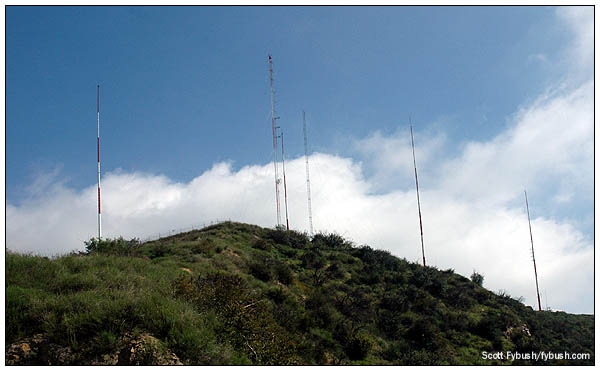
Our fourth stop on this busy Friday is at a site with a long and truly odd history - and a site that's very hard to reach, unless you're either a hardy hiker or you know an engineer. We chose the latter approach, and it was in the company of CBS Radio's Fred Holub that we headed past the gates and up the bumpy fire road to the Verdugo Hills, which rise between Glendale and Burbank.
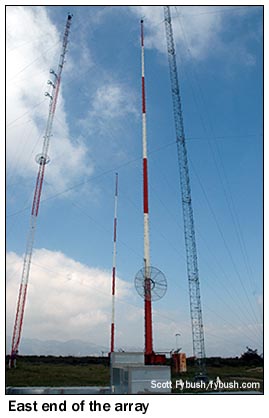 Today,
this site is home to KROQ (106.7 Pasadena) and KXOL (96.3 Los
Angeles), but if it looks like it was once an AM directional
array, that's because it once was - and that brings us to the
history books:
Today,
this site is home to KROQ (106.7 Pasadena) and KXOL (96.3 Los
Angeles), but if it looks like it was once an AM directional
array, that's because it once was - and that brings us to the
history books:
From 1964 until 1984, the six-tower array way up here on the hilltop was home to Burbank-licensed AM 1500, initially KBLA. KBLA had signed on in 1951 as a 250-watt signal on 1490, successor to the short-lived KWIK, which operated on 1490 from 1947 until 1951, when its license was revoked for technical violations. Even in the sixties, land values in the valley were already too high to justify the construction of a huge directional array down there, so when KBLA went for the power increase (to 10 kW days, 1 kW nights) and frequency change, it was relegated to this fairly remote spot 2650 feet above sea level.
In 1967, KBLA flipped to country as KBBQ - and then, in 1972, it went back to the top 40 format it had used in its KBLA days, introducing the now-iconic callsign KROQ to the market.
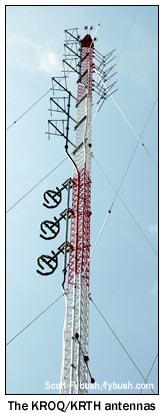 The
next year, KROQ purchased what had been KPPC-FM (106.7 Pasadena),
LA's original "underground" FM station. The newly-renamed
KROQ-FM continued to play progressive rock, and the AM became
mainly a simulcast.
The
next year, KROQ purchased what had been KPPC-FM (106.7 Pasadena),
LA's original "underground" FM station. The newly-renamed
KROQ-FM continued to play progressive rock, and the AM became
mainly a simulcast.
KROQ struggled financially for several years, often failing to pay its airstaff, sometimes going off the air for random lengths of time, and occasionally using its transmitter site as a studio - but it also quickly established itself as a major player in the world of what would soon be rechristened "alternative" rock.
Of course, by that point, KROQ's audience had moved almost entirely to the FM signal, and the FM signal had moved up here to Verdugo Peak, relocating from its former home on Flint Peak to the south. Under the ownership of Infinity Broadcasting (and later CBS Radio, Infinity and now CBS Radio again), KROQ-FM eventually became (and still remains) one of the market's biggest and most important stations.
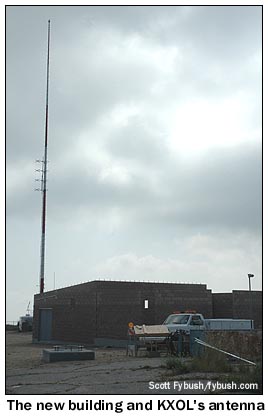 The
AM, meanwhile, went Spanish for a few years in the early 1980s,
then went dark in late 1984 when it and the FM were sold to separate
owners. The AM went to Ed Stolz' Royce Broadcasting, and under
the calls KRCK and later KIEV, it would remain on the FCC rolls
for many years thereafter, applying for new cities of license
(Culver City) and new transmitter sites along the way, though
never returning to the air.
The
AM, meanwhile, went Spanish for a few years in the early 1980s,
then went dark in late 1984 when it and the FM were sold to separate
owners. The AM went to Ed Stolz' Royce Broadcasting, and under
the calls KRCK and later KIEV, it would remain on the FCC rolls
for many years thereafter, applying for new cities of license
(Culver City) and new transmitter sites along the way, though
never returning to the air.
When KROQ (under CBS) came under common ownership with KRTH (101.1 Los Angeles), the site became home to an auxiliary transmitter for "K-Earth." Today, the KRTH auxiliary antenna sits just below KROQ's own antenna on a guyed tower just north of the old line of four AM towers. (That's a KROQ auxiliary antenna below the KRTH aux and the KROQ main.)
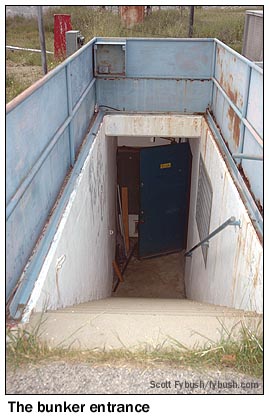 A few
years ago, when a format change at Spanish Broadcasting Systems'
KXOL (96.3 Los Angeles) led to that station being evicted from
its site on Flint Peak, a four-bay antenna was hastily rigged
on another of the old AM towers and a transmitter installed in
a trailer at the base.
A few
years ago, when a format change at Spanish Broadcasting Systems'
KXOL (96.3 Los Angeles) led to that station being evicted from
its site on Flint Peak, a four-bay antenna was hastily rigged
on another of the old AM towers and a transmitter installed in
a trailer at the base.
That, however, is merely a temporary solution, and during our April visit to the site there was major construction work underway that will dramatically change the face of Verdugo Peak.
The building shown in the foreground of the KXOL picture above will eventually house KXOL itself, along with auxiliary transmitters for the rest of CBS Radio's Los Angeles FM stations - KCBS-FM (93.1), KTWV (94.7) and KLSX (97.1) - thus providing an alternative site if those stations experience trouble with their main transmitters on Mount Wilson. (KRTH's aux will remain as well, but its transmitter, and KROQ's, will stay underground.)
A massive (seven-foot face) new tower has now been erected on the pad seen at the left side of the photo to provide space for all those antennas, and the building's completed now, too.
Remarkably, this building is the first above-ground structure at this site. When KBLA came up here in 1964, it put its transmitter in an underground bunker, and in good Cold War fashion the bunker was equipped with a rolling concrete blast shield that could be moved into place above the stairwell, though it's not clear what good it would have done if the power lines and towers above ground had been wiped out. (Veteran LA engineer Burt Weiner says he visited the site when it had just been completed, and he was told then that the idea behind the underground transmitter room was to provide RF shielding for KBLA's audio equipment.)
Look very closely at the stairwell photo above; those are rails on either side of the stairwell, and there's a flip-up metal door at the rear that allows the concrete slab to be moved into place. The last time anyone tried to do it, as a joke a few years ago, they discovered a fire-ant nest under the concrete - and we've heard that there are rattlesnakes down there, too.
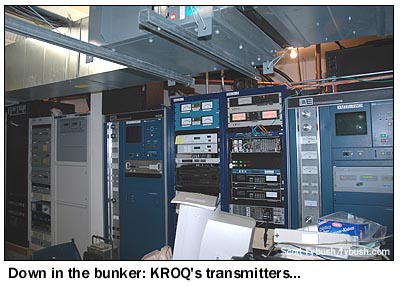 |
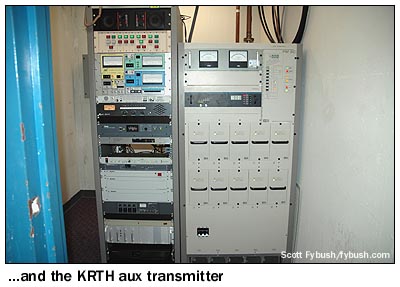
|
So with all that historical preface out of the way, shall we descend the steps into the famed transmitter bunker and see what lies beneath?
It's a small space, perhaps 20 by 25 feet, and so any signs of the station's AM history have long since given way to the current FM installation. (There's one tiny bit of history to be seen, if you know what you're looking at - an old toolbox is marked "KMPX FM 107," the long-ago San Francisco sister station of the old KPPC-FM.)
Along one wall are the KROQ-FM transmitters - a Harris Z10FM at left (with HD Radio exciters just left of the transmitter) as the main and two BE FM-5As at right for auxiliary use. Across from the Harris is a little closet housing the BE FM-5C that serves as KRTH's aux. Was this closet once the KROQ studio when they were broadcasting from the bunker? There's not much other space up here to use - just a desk, a little fridge and some test gear to round out the room.
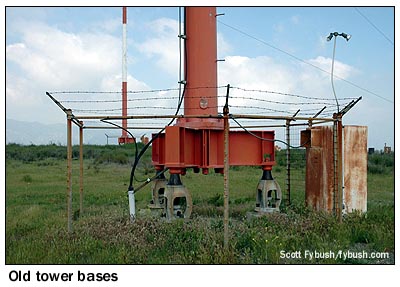 |
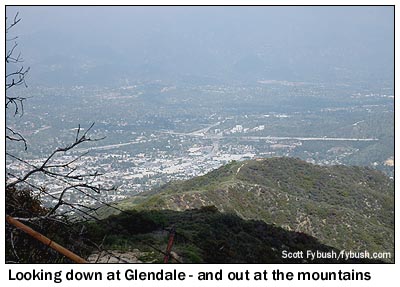
|
Our tour concludes back out amidst the towers. At the time of our visit, four of the original monopoles still existed - three of the four that ran in an east-west line along the hilltop and one of the two towers that sat perpendicular to the in-line array.
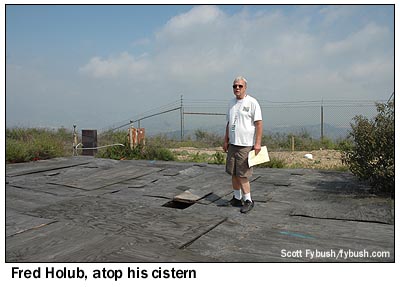 Out
by the easternmost tower, Fred shows us one more unusual feature
of this site. In search of a solution to the miserably poor ground
conductivity that kept the AM signal from getting out very well,
the station dug a 12-foot-deep cistern to collect rainwater,
then installed a sprinkler system that periodically irrigated
the ground around the towers. It didn't do much, but the cistern
is still there, covered by plywood.
Out
by the easternmost tower, Fred shows us one more unusual feature
of this site. In search of a solution to the miserably poor ground
conductivity that kept the AM signal from getting out very well,
the station dug a 12-foot-deep cistern to collect rainwater,
then installed a sprinkler system that periodically irrigated
the ground around the towers. It didn't do much, but the cistern
is still there, covered by plywood.
We're glad we got to this site just in time to get a decent idea of what it was like in its AM incarnation, and as it begins its new life as a fairly major FM installation, we're looking forward to getting back up into the hills (perhaps before NAB next year) to see the completed FM auxiliary building and the new FM tower.
Meanwhile, in next week's installment, we'll take you to another former Los Angeles AM site in the hills - also with an FM history. Stay tuned!
|
STILL HERE - BUT WE NEED YOUR SUPPORT: If you're a fan of the national radio message-board sites, you're probably feeling a little disoriented lately by all the changes they're going through. (We are, too, though we've pretty well settled on the new radioinsight.com as the friendly spot to talk about all things radio and TV.) Here at fybush.com, we're now in our twelfth year of regular, uninterrupted service to our readers, and we're not going anywhere. Same address, same weekly columns, same old design. (OK, perhaps a few things could use some freshening this year.) And if we've learned anything after all those years in the radio website business, it's this: good things don't come for free. Or at least when they do, they don't last forever. But thanks to our loyal subscribers and our growing fleet of advertisers, we've built a solid community here. We were here in 1994, we're here in 2006, and assuming there's still a radio dial to cover, we have every intention - with your support - of still being here in 2018. (I wish I could say the same about my hairline.) If you still haven't subscribed yet for this year, do it right now at our Support page - and enjoy another exciting year of Tower Site of the Week and NERW, guilt- (and password-) free. And if you have become one of our many subscribers, thank you! |
- Previous Site of the Week: KMPC 1540, Los Angeles, CA
- Next Week: Former KFSG/KRKD, Montecito Heights, Los Angeles, CA
- Site of the Week INDEX
- How can you help support Site of the Week? Click here!
- Submit your suggestions for a future Site of the Week!
